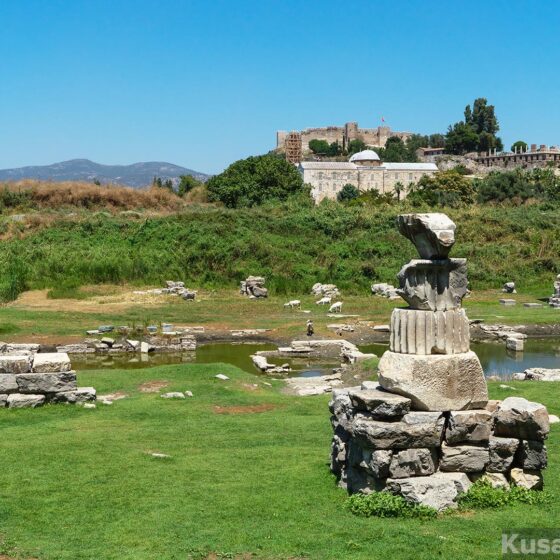Table of Contents Show
The Temple of Artemis at Ephesus, an iconic structure renowned as one of the Seven Wonders of the Ancient World, exemplifies the architectural and artistic prowess of ancient civilizations. Located in what is now Selcuk, Turkey, this grand temple was dedicated to Artemis, the goddess of fertility, hunting, and the moon, serving as a pivotal center for worship and cultural exchange in the ancient Mediterranean world.
Its historical and religious significance, alongside its impressive architectural design, has cemented the temple’s place in the annals of history. Construction of the Temple of Artemis began around 550 BCE, featuring 127 towering columns and a striking Ionic design that harmonized local and foreign artistic influences.
The temple underwent multiple reconstructions following several devastating events, most notably its destruction by fire in 356 BCE, an act attributed to Herostratus, who sought fame through his actions.
Despite these challenges, the temple was rebuilt larger and more elaborate, showcasing the resilience of Ephesus and its citizens’ devotion to Artemis. Throughout its history, the temple significantly impacted Ephesus’s economy and culture, attracting pilgrims and tourists alike. The vibrant festivals held in honor of Artemis not only enhanced local religious practices but also facilitated trade and economic growth, contributing to Ephesus’s prominence in the ancient world.
The temple’s intricate decorations and architectural innovations influenced subsequent temple designs, marking it as a milestone in ancient artistry and engineering. Although the Temple of Artemis ultimately fell into decline and was destroyed in the 5th century CE, its legacy endures as a symbol of ancient ingenuity and cultural heritage. The site remains a focal point for archaeological research, with ongoing excavations revealing insights into its historical significance and the broader context of ancient religious practices.
Today, it continues to captivate scholars, tourists, and history enthusiasts, serving as a testament to the enduring impact of ancient civilizations on contemporary culture.
Overview
The Temple of Artemis at Ephesus stood as a jaw-dropping marvel, earning its spot among the Seven Wonders of the Ancient World. It sat in Ephesus, near today’s Selcuk, Turkey. People built it to honor Artemis, goddess of hunting, fertility, and the moon. This wasn’t just a temple—it turned Ephesus into a bustling hub for worship and trade in the ancient Mediterranean.
Historical Significance
Around 550 BCE, builders began this marvel. They set up 127 columns, each 60 feet high. The Ionic design blended local charm with outside ideas. Then, in 356 BCE, Herostratus set it ablaze, craving fame. The Ephesians didn’t flinch. They rebuilt it—bigger, bolder—showing their fire and love for Artemis.
Cultural Impact
The Temple of Artemis at Ephesus, renowned as one of the Seven Wonders of the Ancient World, held significant cultural influence throughout the region and beyond. Its existence not only shaped local religious practices but also played a pivotal role in the economic and social landscape of Ephesus.
Religious Significance
The temple was a central hub for the worship of Artemis, the goddess of fertility, hunting, and the moon, and attracted pilgrims from across the ancient world. The elaborate rituals and ceremonies held at the temple reflected the spiritual life of the Ephesians, fostering a deep connection between the community and their deity. These rituals often included offerings and processions, which engaged thousands of participants and visitors, thus enriching the city’s cultural fabric.
Economic Influence
It boosted the economy too. Builders and workers stayed busy keeping it up. Festivals like Artemisia pulled in tourists. Vendors sold food and goods. Trade boomed. Ephesus grew rich and strong.
Artistic Legacy
Architecturally, the Temple of Artemis combined various styles and motifs, including local Ionian designs and influences from other cultures, reflecting the eclectic artistic tastes of the time. The temple’s grandeur and the intricate sculptures that adorned its columns and friezes became a benchmark for future architectural endeavors, inspiring generations of architects and artists alike. The richness of the temple’s decoration and its artistic significance resonated throughout the ancient world, establishing a legacy that extended far beyond its physical structure.
Historical Resilience
Throughout its history, the Temple of Artemis demonstrated remarkable resilience amidst destruction and reconstruction. Its frequent rebuilding following catastrophic events, such as the fire set by Herostratus and later invasions, illustrates its enduring cultural importance. This cycle of destruction and revival allowed the temple to adapt to changing political and cultural climates while preserving its central role in Ephesus’s identity.
Lasting Influence
Despite its eventual decline and ultimate destruction in the 5th century AD, the legacy of the Temple of Artemis continues to inspire awe and admiration. It serves as a reminder of ancient craftsmanship and cultural achievements, reflecting the human spirit’s creativity and determination. The temple remains an emblematic symbol of Ephesus, drawing interest from historians, archaeologists, and tourists who seek to understand its significance in the context of ancient civilization.
Archaeological Insights
Archaeological efforts at the site have uncovered remnants of its once-majestic structure, providing insights into ancient engineering and artistry. Recent discoveries, including inscriptions and coins, continue to shed light on the temple’s role in the economic and social life of Ephesus, further cementing its legacy as a pivotal site in ancient history. Today, the Temple of Artemis remains a symbol of cultural heritage, embodying the ingenuity and aspirations of the ancient world.
History
The Temple of Artemis, located in Ephesus, has a rich and tumultuous history that reflects the city’s significance in the ancient world. Founded by Ionian Greeks around 1000 BCE, Ephesus quickly grew into a vital center for trade and culture, which would later contribute to the prominence of the temple dedicated to the goddess Artemis.
Early Construction and Significance
The earliest known temple on the site was constructed in the 8th century BCE. This peripteral temple was significant as it represents one of the earliest examples of such architectural design in the region. The temple underwent several reconstructions and expansions over the centuries, notably under the patronage of King Croesus of Lydia (c. 560-546 BCE), who funded the construction of a grander temple that featured impressive columns, reinforcing the temple’s role as a central worship site for Artemis and a symbol of Ephesus’s wealth and cultural importance.
Destruction and Rebuilding
A pivotal moment in the temple’s history occurred in 356 BCE when it was set ablaze by Herostratus, who sought notoriety through this act of arson. The destruction coincided with the birth of Alexander the Great, leading to legends that attributed the fire to the goddess’s distraction during his delivery. In the aftermath, the Ephesians executed Herostratus and imposed a ban on his name to prevent him from gaining fame. Despite its initial destruction, the temple was quickly rebuilt, showcasing the resilience of the city and its devotion to Artemis. This new structure was larger and more elaborate than the previous versions and became one of the Seven Wonders of the Ancient World, renowned for its grandeur and architectural ingenuity.
Final Destruction
The temple faced further destruction during the Roman period when it was plundered by the Goths around 267 CE and later destroyed definitively in 401 CE by a Christian mob inspired by the decrees of Emperor Theodosius I against pagan practices. Following its final destruction, the site fell into disrepair and was eventually buried under layers of silt from the nearby Kaystros River, leading to a gradual decline of the city itself. Today, the remnants of the Temple of Artemis continue to draw visitors and scholars alike, standing as a testament to the historical significance of Ephesus and its enduring legacy in ancient architecture and worship practices.
See also: Discover Ephesus: Book Your Ephesus Tour Today
Last updated on March 7, 2025



